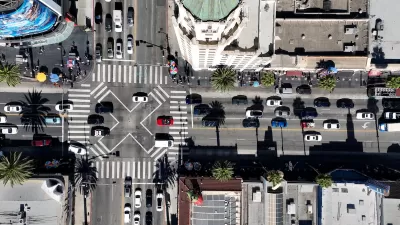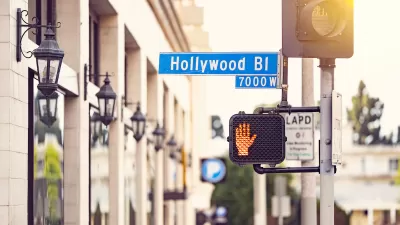Commentator D.J. Waldie laments the stunning health hazards for L.A.'s pedestrians, and proposes five solutions to make the city safer for those on foot.
Los Angeles has a much higher than average pedestrian fatality rate, according to a University of Michigan study [PDF], and an epidemic of hit-and-run collisions, as a recent LA Weekly exposé unveiled. As the city puts "more walkers and more vehicles into closer proximity" through increased density, and seeks to increase the amount of non-vehicular trips, Waldie argues that it's time for the city to take steps to improve pedestrian safety. His solutions include: using data to determine the most dangerous places for pedestrians, vigorously prosecuting hit-and-run drivers, investing more in pedestrian infrastructure, making pedestrian safety a more central focus of community safety, and improving crosswalks and intersection signaling and lighting.
"But real safety for pedestrians will have to come from drivers themselves," he concludes. "There is a callousness built into the design of modern vehicles - so perfectly do they respond to every desire in traffic-jammed Los Angeles except the desire for freedom. It's a terrible contradiction for drivers in L.A. to have everything a car can give except mobility."
"I can sometimes see the frustration in a driver's face (despite my weak eyes) when he swings into an intersection, aiming his comfortable weapon where I walk. I wonder if he sees me at all."
FULL STORY: To Walk and Die in L.A.

Planetizen Federal Action Tracker
A weekly monitor of how Trump’s orders and actions are impacting planners and planning in America.

Restaurant Patios Were a Pandemic Win — Why Were They so Hard to Keep?
Social distancing requirements and changes in travel patterns prompted cities to pilot new uses for street and sidewalk space. Then it got complicated.

Maui's Vacation Rental Debate Turns Ugly
Verbal attacks, misinformation campaigns and fistfights plague a high-stakes debate to convert thousands of vacation rentals into long-term housing.

Boulder Eliminates Parking Minimums Citywide
Officials estimate the cost of building a single underground parking space at up to $100,000.

Orange County, Florida Adopts Largest US “Sprawl Repair” Code
The ‘Orange Code’ seeks to rectify decades of sprawl-inducing, car-oriented development.

Maui's Vacation Rental Debate Turns Ugly
Verbal attacks, misinformation campaigns and fistfights plague a high-stakes debate to convert thousands of vacation rentals into long-term housing.
Urban Design for Planners 1: Software Tools
This six-course series explores essential urban design concepts using open source software and equips planners with the tools they need to participate fully in the urban design process.
Planning for Universal Design
Learn the tools for implementing Universal Design in planning regulations.
Heyer Gruel & Associates PA
JM Goldson LLC
Custer County Colorado
City of Camden Redevelopment Agency
City of Astoria
Transportation Research & Education Center (TREC) at Portland State University
Camden Redevelopment Agency
City of Claremont
Municipality of Princeton (NJ)




























